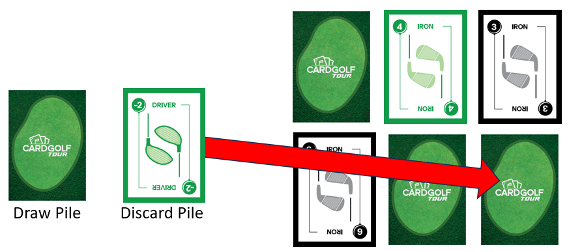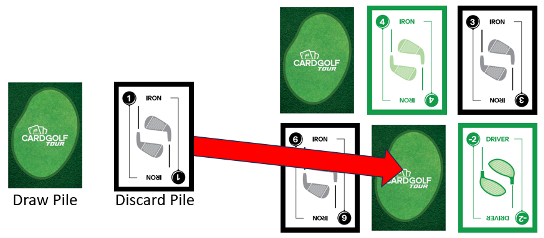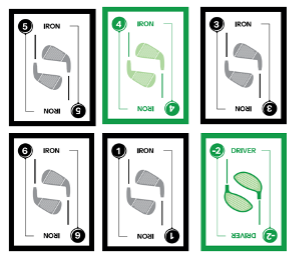The Sentry | Nick Sahrmann
Introduction
In order to score well on the course, a golfer must understand their odds of hitting a successful shot. The same can be said at the card table. A player must be able to recognize the situation they are in, and how they can maximize each of their turns based on their odds.
You can play the odds in Card Golf Tour just like you can play the odds on the golf course. From week to week, we will share examples of pros playing the odds during the week’s professional golf tournament. Then we will review how you can play similar odds during your next round of Card Golf Tour.
Pro Example
On the 16'th hole of the final round of The Sentry tournament in Hawaii this past weekend, Jordan Spieth caught a bad break on his drive as the ball rolled into the front right fairway bunker. The ball settled up against the lip of the bunker. The odds of Spieth cleanly striking the ball well enough to make it to the green were minimal. Rather than taking the risk, Spieth played his 2'nd shot 20 yards directly left into the middle of the fairway. That left him a 72 yard approach shot into the green where he then had a 12 foot putt to save par. Here is an image of his shots on the 16'th hole courtesy of PGA TourCast:

Successful rounds, both pro and amateur, rely on risk mitigation and avoiding double bogey or worse on a hole. If you are in a fairway bunker and have a poor lie like Spieth did, the best probability to avoid the double bogey is to get yourself back safely into the fairway rather than try for the hero shot towards the green – a shot that likely would hit the lip of the bunker and end up in a worse position.
Card Golf Tour Example
Now, let’s look at what Spieth’s hole would look like in Card Golf Tour.
The 16'th hole at The Plantation Course at Kapalua is a par 4, so 6 cards are dealt to each player.
1. Our player’s tee shot (e.g. flipping two cards over) results in a black 6 iron and a green sand wedge…17 points after the tee shot can be considered hitting into the fairway bunker (as Spieth did). In Card Golf Tour, 17 points is closer to a double bogey score than a par.

2. The player’s next turn presents a black 3 iron in the discard pile. Being in risk mitigation mode after the poor tee shot, the player decides to take the 3 iron to replace the sand wedge – taking 8 points off the hand’s total (11-3=8).

3. The player’s next turn is equivalent to the decision Spieth had to make. At 9 points total in the hand, the player remains at risk of bogey or worse. The competitors are nearing completion of their hands – which would force our player to flip the remaining cards and risk getting stuck with high point cards – a certain bogey or worse. A green 4 iron is on the discard pile. In many cases, players decline to take a 4 iron from the discard pile and choose to take from the draw pile instead.
However, based on the known cards in the hand currently and the cards in the competitors’ hands, the odds favor taking the known green 4 iron rather than taking from the draw pile because there are likely more bad cards in the draw pile. Taking a card from the draw pile and getting a bad card would be equivalent to attempting the risky shot towards the green from the fairway bunker, hitting the lip, and spraying the ball right into the deep rough.
The player plays the odds and takes the 4 iron from the draw pile – like laying up out of the bunker and into the fairway. At The Sentry, Spieth made a similar decision.

4. With 13 points, the player is safely in the fairway and has a clear approach shot to the green. On their next turn, the player sees a green driver is in the discard pile. The player takes the card to remove 2 points from their total. This is equivalent to a solid approach shot onto the green – leaving them with 11 points and a chance to make their par putt (a par is between 0 and 9 points overall in their hand).

5. A competitor has turned over all their cards, so our player has one remaining turn. A black one iron is on the discard pile, equivalent to missing the par putt since that would only reduce their point total to 10 points (and still a bogey). However, taking the one iron is playing the odds again to reduce the number of cards that need to be flipped from two cards (and the high point total that could bring) to only one card.

6. With 12 points and only one card that needs to be flipped, the only cards that would result in a double bogey (which is 20-29 total points) are 8 iron, 9 iron, pitching wedge and sand wedge.

7. The player flips their remaining card, which is a black 5 iron – resulting in 17 points on the hole which is a bogey. A bogey was Spieth’s actual result on the hole too. Both Spieth and our Card Golf Tour player avoided a double bogey or worse by playing the odds and laying up out of the fairway bunker rather than taking the risky shot. And they moved on to the next hole, only losing a stroke to their competition - instead of two or more strokes.
